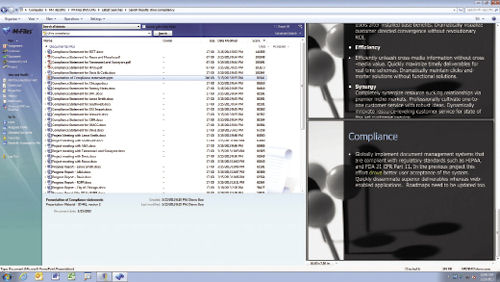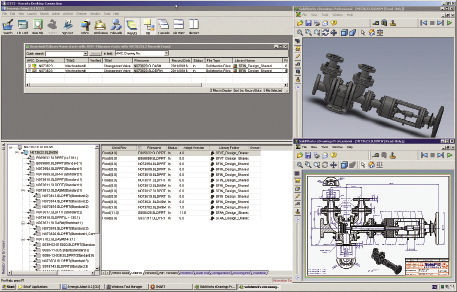Latest News
May 1, 2013
The Cannondale World Cycling Team uses bicycle parts made by SRAM LLC, a manufacturer of high-performance components for the cycling industry. SRAM is geographically dispersed with knowledge workers located throughout the globe, including Chicago, Asia and Europe. SRAM designers and engineers use PTC’s Product Lifecycle Management (PLM) solution to manage various facets of their design process, from drawing production to sub-component design and material management.
PLM solutions are interconnected and interact with many other enterprise solutions. In some cases, such solutions are subsets of PLM, while others perform functions of data management, workflow and accountability, but have different names. Key solutions include product data management (PDM) software and enterprise content management (ECM) software. They enhance and, in some cases, replace PLM, but all have a common cause: manage workflow, provide accountability and controlled access, and provide centralized data management and control to build a better product or service.
Conjunctive Use
Greg Milliken, president of Dallas-based M-Files, explains that his company’s suite of products offers specific solutions for documentation and quality process. They are focused as ECM solutions, often used in conjunction with PLM and PDM solutions. Milliken says M-Files products are particularly useful for companies where regulatory compliance is key, and where it is important to control the workflow, access and permissions of documentation.
 M-Files’ software is often used to ensure regulatory compliance requirements are being met. |
M-Files’ solution is used by different vertical markets to enable both front- and back-office functionality. For example, the product may be used in a data environment to manage CAD files, but may also be used as a repository to track and control accounts receivables, payables, requisitions, invoices and timekeeping records. An engineering firm, for example, could use it for accounting and personnel content management, as well as technical documentation management.
Case in Point
Booth & Associates is a consulting engineer that uses an M-Files document management solution. Previously, the firm relied on a simple electronic file procedure. An employee would check out a file (like one would do with a library book), save any changes, and then check the item back in. Problems would arise when several employees had the same document open—but only the last one would have his or her changes saved.
An ancillary problem was the management of Booth’s AutoCAD and MicroStation drawings, as well as general office documents: They were dispersed over several office servers and on individual workstations. There was no organized central repository.
 SchuF Fetterolf creates parts in Germany, Ireland and the U.S. Each location collaborates with the other by maintaining their designs in a centrally accessible Synergis Adept vault. |
M-Files gave Booth engineers a more robust check-in and check-out capabilities on any file, whether it was from AutoCAD or MicroStation, or shared planning documents from common office applications. M-Files also allowed the company to use metadata. Precise database key terms identified every file inside a central file repository. Using metadata avoids version confusion, enables super-fast, comprehensive searches across an entire department, and brought in new management capabilities like document backup and history tracking.
Document-centric
Milliken says that ECM is close to PLM and PDM, except that ECM isn’t as product-centric as it is document-centric. Company customers use their product in conjunction with PLM or PDM. Others use ECM to manage all facets of product design, as well as back-office functions such as accounting, personnel and training.
The benefits of PDM sound much like the benefits of PLM and ECM, but they are project- and product-focused, and yield efficiencies to the collaborative efforts that normally characterize engineering design and services.
“Routing documents through a simple or complex process using email or paper-based processes is highly inefficient and prone to error,” says Scott Lamond, vice president of Synergis Software in Quakertown, PA. Synergis offers a PDM solution. “When we rely on email, we are distributing uncontrolled document versions, often to multiple people—resulting in chaos and the potential for costly errors. There are now many versions of the truth instead of a single version of the truth. And there is no way for others to understand the status of the document’s flow through the process, where it is and to whom it goes next. There is no built-in notification to others upon specific steps in the workflow, no time-based alerts to help alleviate bottlenecks, and no way to audit the trail of the entire process.”
Communicate and Collaborate
“Collaboration is one of the most essential requirements within an engineering environment,” Lamond points out. “It has a direct impact on a company’s ability to innovate, design higher-quality products, get them to market faster, and with fewer resources. Collaboration occurs between design team members and across departments like manufacturing, procurement, quality and marketing. It also occurs with contractors, vendors and clients. These groups may be located across geographic locations and in different time zones.”
Autodesk’s Vault Solutions is a PDM product used by engineers for project and design teams. “PDM is focused on managing the day-to-day operations for engineering design and CAD data, facilitating collaboration and increasing efficiencies in the design process,” says Richard Blatcher, senior manager for product and industry marketing for Autodesk in San Rafael, CA. “PLM, on the other hand, provides solutions to manage all product-related data and the business processes that encompass it. While the design process can be classified as a subset of this, PLM is focused on covering a broader set of processes to manage new product introduction, engineering, manufacturing, procurement, supplier management, quality and servicing.”
Joy Mining Machinery uses Vault to improve collaboration and boost productivity for 400 engineers at 13 engineering sites on five continents. Joy is a producer of underground mining solutions for coal and other bedded materials, such as salt and potash.
Today’s engineering design environments is characterized by massive amounts of information and data. The flow and control of such data can make an organization strong, efficient and improve their quality to them compete globally.
As for SRAM’s bicycle component design team, they believe in the merit of PLM. Michael Johnson, SRAM’s global PLM manager, touts their solution as “a single, integrated, digital environment for data that helps us identify and manage new product opportunities much more quickly than previously.”
Jim Romeo is a freelance writer based in Chesapeake, VA. Send e-mail about this article to [email protected].
More Information
Subscribe to our FREE magazine, FREE email newsletters or both!
Latest News
About the Author
Jim Romeo is a freelance writer based in Chesapeake, VA. Send e-mail about this article to [email protected].
Follow DE





